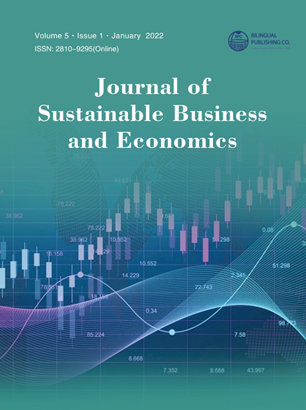-
255
-
176
-
158
-
128
-
125
Increasing Efficiency through Tokenization of Digital Assets in an Exporting Company 4.0
DOI:
https://doi.org/10.30564/jsbe.v5i1.4Abstract
Digital assets have been introduced to the global market as one of the innovations with the potential. Even though their impact on the traditional economy is impossible to measure. Security tokens (ST) are the ones that stand out due to the preference they have from producers and consumers. The former obtains financial resources efficiently for their specific projects. While the latter look for STs in global digital platforms of trust and security. Which are regulated by public securities sales offices. The research proposes a method under the fuzzy logic theory and its applied models. It highlights the use of the triangular fuzzy numbers, the Fuzzy Delfi, Expertons, Hamming Distance, and the fuzzy inference system (FIS). The benefits and limitations of the proposal were highlighted when the proposal was used in an agro-export company. The route or algorithm of the value system to be followed in the execution of the investments stands out. Therefore, the research fulfills its objective and is very useful for small and medium export 4.0 companies. Since they are eager to obtain cash flow to improve their technical efficiency and to be able to export their artifacts to global markets. That is to say, the producer of goods can obtain an unprecedented benefit in an agile and efficient way in the context of Industry 4.0.
Keywords:
STO; ST; SME; Industry 4.0; Asset tokenizationReferences
[1] HkbitEx, 2021, What is a Digital Asset and why dote it matter? Link: https://bit.ly/3dCQcIk (Accessed December 10, 2021).
[2] Mazzorana-Kremer, F., 2019. Blockchain-Based Equity and STOs: Towards a Liquid Market for SME Financing? Link: https://bit.ly/3EvX9pH (Accessed December 01, 2021).
[3] Somin, S., Gordon, G., Pentland, A., Shmueli, E., Altshuler, Y., 2020. ERC20 Transactions over Ethereum Blockchain: Network Analysis and Predictions. Link: https://bit.ly/3sEVDzm (Accessed December 2, 2021).
[4] William, L., He, S., 2017. Blockchain Disruption and Smart Contracts, Link: https://bit.ly/315IUKG (Accessed November 10, 2021).
[5] Oestreich, V., 2013. Industrie 4.0. CHEManager, p. 9,Link: https://bit.ly/3koeerX (Accessed January 20, 2021).
[6] Falempin, L., Coheur, D., Van Hecke, P., Walsh, E., 2019. Tokenized Securities, The Ultimate Handbook on How to Issue Compliant. Tokeny. pp. 25.
[7] Gil Aluja, J., y Kaufmann, A., 1998. Operational Management Techniques for the Treatment of Uncertaint. Hispana Europea, España. pp. 20.
[8] Zadeh, L., 1996. Fuzzy Logic = Computing with Words. IEEE: Transactions on Fuzzy Systems, Vol. 4, N°2, Link: https://bit.ly/30mZVM (Accessed June 15, 2020).
[9] Gil Aluja, L., y Kaufmann, A., 1986, Introduction of the Fuzzy Subset Theory to Business Management. Editorial Milladoiro, España. pp.156.
[10] Gil Aluja, L., y Kaufmann, A., 1986. Special Techniques for Expert Management. Editorial Milladoiro, España. pp.189.
[11] Izadikhah, M., 2009. Using the Hamming Distance to Extend Topsis in a Fuzzy Environment, p. 201, Link: https://bit.ly/3HnN14r (Accessed November 08, 2020).
[12] Abraham, A., 2005. Adaptation of Fuzzy Inference System Using Neural Learning, p. 55, Link: https:// bit.ly/3pB8ssy (Accessed June 08, 2021).
[13] Platform 4.0, 2015. Das Referenzarchitekturmodell Industrie 4.0 (RAMI 4.0), p. 1, Link: https://bit. ly/3ecsK5l (Accessed January 15, 2020).
[14] Zadeh, L.A., 2001. Fuzzy Logic and Approximate Reasoning, p. 425, Link: https://bit.ly/3mEWnRi (Accessed June 21, 2021).
[15] Hines, B., 2021. Digital Finance - Security Tokens and Unlocking the Real Potential of Blockchain, Published by John Wiley, Link: https://bit.ly/3peBOwN (Accessed December10, 2021).
[16] Rueda, T., 2021. Digital Token Taxonomy: A winding path towards a necessary global convergence, Revista Blockchain Inteligencia Artificial, N°2, p. 82, Link: https://bit.ly/3yC7Eqf (Accessed December 10, 2021).
[17] Colling, S., 2021. Security tokens will grow to $ 162 trillion in trading volume by 2030, Yahoo Finance, Link: https://yhoo.it/3GJY4ob (Accessed December 12, 2021).
[18] Trigueros, J.A., 2018. An Alternative Proposal for Financing for the Agricultural Sector (Agricultural SME’s Bonds), p. 25, Link: https://bit.ly/3qdXys0 (Accessed December 08, 2021).
[19] Layr, A., 2021. Tokenization of Assets: Security Tokens in Liechtenstein and Switzerland, p.69, Link: https://bit.ly/3yOEGDI (Accessed December 10, 2021).
Downloads
How to Cite
Issue
Article Type
License
Copyright © 2022 José Antonio Trigueros Pina, Napoleón B. Alegre Poma

This is an open access article under the Creative Commons Attribution 4.0 International License.




 José Antonio Trigueros Pina
José Antonio Trigueros Pina

